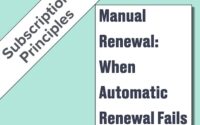How to urgently increase bookings for your subscription business? – Part 2
In the first part of this article, we looked at how to address emergencies while adopting a rational approach. Before taking action, you must verify:
- the objective 🎯,
- the KPIs to be influenced 📊,
- the fair distribution between the Retention and Acquisition business ⚖️,
- and your actual execution capacity 🛠️.
📈 In this second part, we will examine solutions for increasing bookings immediately or at a later date. These solutions will be generic to cover all types of subscription businesses.
1. The mathematical reality 🧮
A subscription business consists of an Acquisition business and a Retention business, which are governed by two formulas:
- Booking (Acquisition) = Traffic 🚦 x Conversion Rate 🔁 x AOV 💵
- Booking (Retention) = Expirations ⏳ x Retention Rate 🔒 x ASP 💰
Expirations correspond to the number of subscriptions sold last year 📅 – this KPI cannot be changed. ASP and AOV are the easiest KPIs to influence, since the merchant decides the selling prices 🧾.
➡️ Therefore, actions aimed at varying AOV and ASP are preferred for a rapid increase in bookings ⚡.
2. Immediate-benefit solutions 🚀
In an emergency context with the objective of increasing AOV and ASP, here are the main solutions to boost bookings right away:
- 💸 Price reduction to attract more subscribers: an increase in CR% will offset the decrease in AOV. (Acquisition only)
- 📈 Price increase: the gain in AOV will exceed the drop in RR%. (Retention only)
- 🧺 Price range expansion: adding higher-priced products will mechanically raise AOV. (Mainly Acquisition)
- 🔀 Cross-sell & Up-sell: provided they are paid and raise AOV. (Acquisition + Retention at end-of-cycle)
- ✨ New features to spark demand: new products, bundles, or payment methods. (Acquisition + Retention)
- 🙅 Incentives not to cancel: for users starting cancellation. Helps limit loss more than generating new bookings. (Retention only)
⚠️ Note: Any price changes (lower/higher/cross-sell/up-sell) will impact next year’s retention rate. Short-term gains from increased AOV often come with long-term retention challenges 📉.
3. Deferred Benefit Solutions 🕰️
When time is on your side ⏳, focus on improving Retention Rate (RR%) instead of price.
Here are long-term strategies for increasing bookings:
- 🔄 Migrate users to channels with higher RR% (e.g., indirect ➡️ direct).
- 🤝 Encourage product usage to drive engagement and increase retention.
- 🎮 Gamify the experience to create product stickiness and user habits.
- 🧾 Prompt users to update payment profiles – fewer billing failures.
- 💳 Promote better payment methods – e.g., push Visa over AMEX for lower fees.
- 📬 Win-back campaigns for ex-subscribers.
- 🧠 Invest in better acquisition sources – prioritize those with higher RR% (e.g., SEO vs. paid social).
4. Today’s Solutions, Tomorrow’s Problems ⚖️
🚨 A strong need for bookings often means you’re in crisis mode. But crises tend to make us focus only on the short term 🕶️.
Before launching actions:
- Evaluate and communicate the future impact on the business.
- 📉 Any price change affects conversion & retention.
- 🔮 Use projected macro KPIs to simulate bookings in future years.
⚠️ Avoid falling into a downward spiral: What works in Year 1 might backfire in Year 2, leaving you with an even bigger gap.
👉 Key Takeaways 👈
- 💰 Increasing retention prices is often the fastest and safest way to generate additional bookings.
- ⚖️ Any price change impacts both retention and conversion rates. A CLV calculation is necessary to ensure that the gain in Year 1 is not lost in Year 2.
- 🔁 Solving a booking problem today can become a retention rate problem tomorrow. However, retention issues cannot be solved with price cuts 💸.



